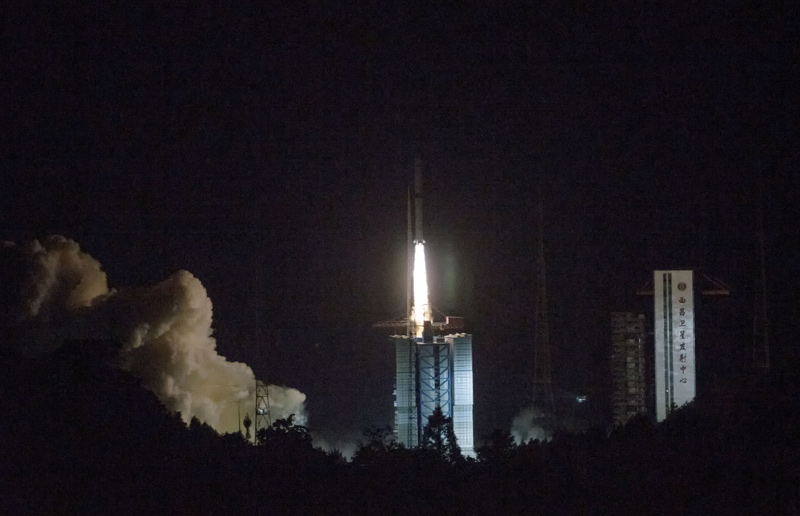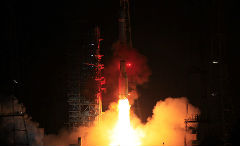China launches relay satellite to explore Moon’s far side
2018-05-21
Xinhua
 A Long March-4C rocket carrying a relay satellite, named Queqiao (Magpie Bridge), is launched at 5:28 am Beijing Time from Southwest China’s Xichang Satellite Launch Center, May 21, 2018. China launched a relay satellite early on May 21 to set up a communication link between Earth and the planned Chang’e-4 lunar probe that will explore the mysterious far side of Moon, which cannot be seen from Earth. [Photo/Xinhua]
A Long March-4C rocket carrying a relay satellite, named Queqiao (Magpie Bridge), is launched at 5:28 am Beijing Time from Southwest China’s Xichang Satellite Launch Center, May 21, 2018. China launched a relay satellite early on May 21 to set up a communication link between Earth and the planned Chang’e-4 lunar probe that will explore the mysterious far side of Moon, which cannot be seen from Earth. [Photo/Xinhua]
XICHANG — China launched a relay satellite early on May 21 to set up a communication link between Earth and the planned Chang’e-4 lunar probe that will explore the Moon’s mysterious far side. The satellite, named Queqiao (Magpie Bridge), was carried by a Long March-4C rocket that blasted off at 5:28 am from Southwest China’s Xichang Satellite Launch Center, according to the China National Space Administration (CNSA). “The launch is a key step for China to realize its goal of being the first country to send a probe to soft-land on and rove the far side of the Moon,” said Zhang Lihua, manager of the relay satellite project. About 25 minutes after liftoff, the satellite separated from the rocket and entered an Earth-Moon transfer orbit with the perigee at 200 km and the apogee at about 400,000 km. The solar panels and the communication antennas were unfolded. Queqiao is expected to enter a halo orbit around the second Lagrangian (L2) point of the Earth-Moon system, about 455,000 km from the Earth. It will be the world’s first communication satellite operating in that orbit. But the mission must overcome many challenges, including multiple adjustments to its orbit and braking near the Moon and taking advantage of the lunar gravity, Zhang said. In a Chinese folktale, magpies form a bridge on the seventh night of the seventh month of the lunar calendar to enable Zhi Nyu, a weavergirl who is the seventh daughter of the Goddess of Heaven, to meet her beloved husband, cowherd Niu Lang. The couple were separated by the Milky Way. Chinese scientists and engineers hope the Queqiao satellite will form a communication bridge between controllers on Earth and the far side of the Moon where the Chang’e-4 lunar probe is expected to touch down later in 2018. The launch on May 21 was the 275th mission of the Long March rocket series. Tidal forces of the Earth have slowed the Moon’s rotation to the point where the same side always faces the Earth, a phenomenon called tidal locking. The other face, most of which is never visible from Earth, is the far side or dark side of the Moon, not because it’s dark, but because most of it remains unknown. With its special environment and complex geological history, the far side is a hot spot for scientific and space exploration. The Aitken Basin of the lunar south pole region on the far side has been chosen as the landing site for Chang’e-4. The region is believed to have great research potential. However, landing and roving require a relay satellite to transmit signals. The Chang’e-4 mission will be more complicated than Chang’e-3, China’s first soft landing on the Moon in 2013. “We designed an orbit around the Earth-Moon L2 point where the relay satellite will be able to ‘see’ both the Earth and the far side of the Moon,” said Bao Weimin, director of the Science and Technology Commission of the China Aerospace Science and Technology Corporation. Establishing a communication link is essential for the success of the Chang’e-4 mission, said Bao. The satellite, weighing about 400 kg and with a designed life of three years, carries several antennas. One, shaped like an umbrella with a diameter of 5 meters, is the largest communication antenna ever used in deep space exploration, said Chen Lan, deputy chief engineer of the Xi’an Branch of the China Academy of Space Technology (CAST). The satellite could stay in the halo orbit around the L2 point of the Earth-Moon system for a long time by using relatively little fuel, thanks to the gravitational equilibrium at that point.



